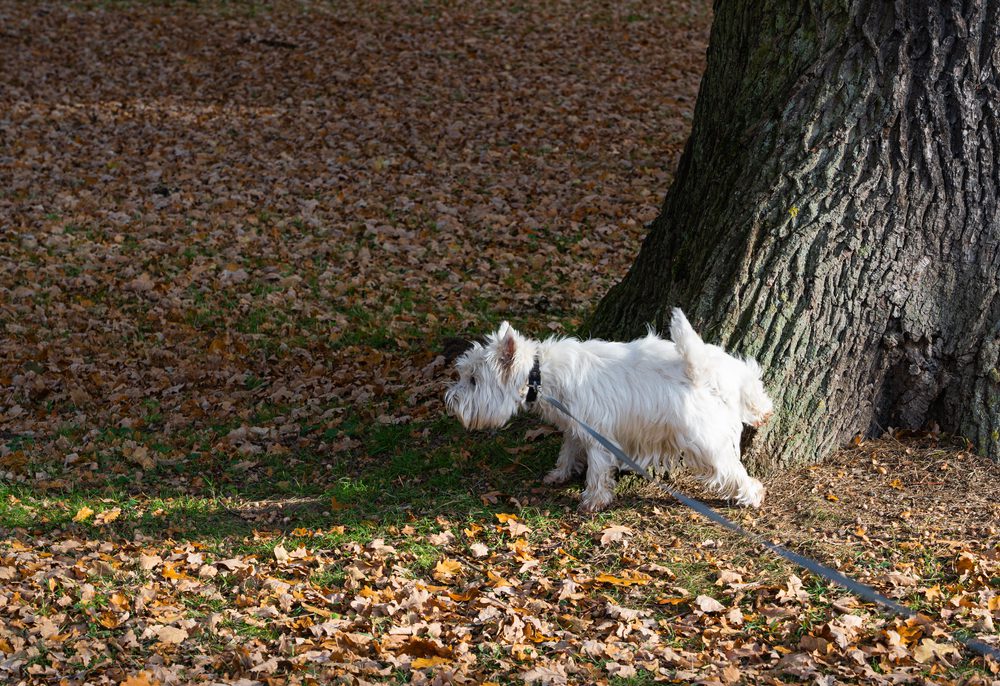A Pet Owners Guide to Bladder Cancer in Dogs: Causes, Symptoms, and Treatment

Table of Contents
What is Bladder Cancer in Dogs?

Bladder cancer in dogs is a tumor that develops due to the abnormal growth of cells in the urinary bladder. This type of tumor of the urinary tract is relatively rare in dogs and accounts for about 1% or less of all canine tumors.
Bladder cancer is usually diagnosed in the late stages. This is because the obvious symptoms and signs of bladder cancer in dogs are similar to those of urinary tract infections (UTI). Plus, invasive transitional cell carcinoma, as the most common type of bladder cancer in dogs, develops really quickly and aggressively.
What Happens When a Dog Gets Bladder Cancer?
In the early stages of urinary bladder cancer, there are usually no serious signs and symptoms. As the disease progresses, it starts to show signs identical to those of a urinary tract infection. The signs include frequent urination, painful urination, bloody urine, producing larger volumes of urine, and more accidents in the house.
Symptoms will improve with anti-bacterial treatment but will soon reemerge. In the event of a bladder infection whose signs persist after treatment, you should seek medical advice and ask your vet to test for bladder cancer.
If treatment for bladder cancer doesn’t start in time, it will start to spread to other organs outside the urinary system like the lungs, regional lymph nodes, bones, and others. Over 20% of bladder tumors are caught after metastasis which further worsens the prognosis.
Types of Bladder Tumors in Dogs
There are different types of bladder tumors in dogs based on the type of tissue the cancerous cells stem from. Here are the most important types of bladder cancer in dogs.
Transitional Cell Carcinoma (TCC). Transitional Cell Carcinoma (TCC) is a type of bladder cancer in dogs that starts in the epithelial cells lining the inside of the bladder. It is the most common type of urinary bladder cancer in dogs. Sadly, TCC is very invasive, and dogs with this type of bladder tumor have a poor prognosis.
Leiomyosarcomas. This is a type of malignant tumor that grows in the smooth muscles of the bladder. Leiomyosarcomas of the bladder are a less common tumor type and account for around 12% of all bladder cancer cases in dogs.
Fibrosarcomas. A fibrosarcoma is a malignant tumor that starts in the soft tissue structures of the bladder. The bladder fibrosarcoma is an aggressive type of bladder cancer in dogs. Luckily, bladder fibrosarcomas are very rare.
These malignant types of bladder cancer in dogs must be differentiated from benign tumors, polyps, and thickening of the bladder walls.
What Causes Bladder Cancer in Dogs?

The exact cause of bladder cancer is unknown in most cases. It is usually triggered by a combination of specific causes and risk factors such as:
- Age. Bladder cancer is more common in middle-aged and older female dogs. The cancer is most commonly diagnosed in dogs that are ten years or older.
- Sex. Female dogs have an increased risk of developing bladder cancer than male dogs.
- Genetics. Genes play a role in determining a dog’s risk for bladder cancer. A test known as the CADET Braf test has been developed to test for the presence of a specific gene mutation that is believed to elevate bladder cancer risk in dogs.
- Breed. Certain breeds of dogs have a higher risk of bladder cancer. The group of risk breeds includes Shetland Sheepdogs, Scottish Terriers, West Highland Terriers, and Beagles.
- Chemical exposure. Studies have found a relationship between chronic exposure to lawn chemicals like pesticides and herbicides and the risk of bladder cancer. Research is still ongoing, but it is worth noting for pet parents who use lawn care chemicals often.
- Inflammation and Infections. It is suggested that chronic and frequent infections and inflammations of the dog’s urinary system increase the risk of developing bladder cancer. For example, a bladder stone can trigger chronic inflammation, which in turn may cause bladder cancer.
What are the Symptoms of Bladder Cancer in a Dog?

The common symptoms of bladder cancer are almost identical to those of bacterial infections of the urinary tract, and they include:
- Frequent urination in small amounts
- Painful urination
- Blood spots in the urine
- Persistent urinary tract or bladder infection even with treatment
- Urination accidents in the house.
Not all clinical signs of bladder cancer in dogs are related to the urinary tract. For example, bladder tumors can also cause some non-specific health problems such as:
- Decreased appetite
- Weight loss
- Lethargy
- Decreased energy levels.
Diagnosing Bladder Cancer in Dogs
Diagnosing bladder cancer in dogs is a lengthy process that requires several tests and procedures. The diagnostic tests your veterinarian may perform for bladder cancer include:
- Physical examination. All diagnostic procedures start with the basic physical examination. The vet will palpate the dog, and in the case of large tumors, they will be able to feel them as swellings of the abdomen. The physical examination can also provide evidence of lymph node spread.
- Urinalysis. Bladder cancer causes changes in the urine composition. Vets test a urine sample to check for the presence of cancer cells. The test for cancerous cells in urine is known as the Veterinary Bladder Tumor Antigen Test (VBTA). Positive results are not always indicative of a presence of a tumor as these cells can be linked with bladder infections too. However, a negative result means that the dog does not have bladder cancer. Since the free-catch urine sample can be contaminated, the vet may extract urine directly from the bladder or via a catheter.
- Complete blood count. Bladder cancer rarely causes any changes in the blood profile. Blood tests are done to test your dog’s kidney function and to check the overall health. The overall health status is important in determining what type of treatment is best for the dog.
- Radiographs. X-rays on their own can’t diagnose bladder cancer. The main use of radiography is to determine if there is cancer spread to the bones. Chest x-rays are used to check for metastasis in the lungs.
- Ultrasound. Abdominal ultrasound is a non-invasive way of estimating the size and site of the tumor. The most common place for bladder cancer in dogs is the neck of the bladder. However, variations are possible.
- CADET Braf test. The CADET Braf test is a fairly new test that vets use for the diagnosis of bladder cancer. It tests for a genetic mutation that is indicative of bladder cancer and also helps to determine how far the disease has progressed in a dog.
- Biopsy. This is the confirmatory test for bladder cancer in dogs. A biopsy is a surgical excision of a tissue sample of the tumor. The sample is processed and then analyzed under a microscope to determine its cancerous properties.
How do You Treat Bladder Cancer in Dogs?

The most common treatment options for bladder cancer, as well as dog anal gland cancer, are surgery, chemotherapy, and radiation therapy. Here is a closer look at different cancer in dogs treatment options.
Surgery. Due to the location of the cancer of the bladder, surgical removal of the tumor is not always an option. Namely, bladder cancer tumors are usually on the lower neck of the bladder (the place where the ureters meet the bladder), which means there is a high risk of damage. If full surgical removal of the tumor is not possible, surgery is still performed to reduce the size of the bladder tumor (debulking surgery). Debulking temporarily improves the dog’s quality of life, but the tumor will grow back.
Chemotherapy. Chemo is rarely effective for bladder cancer in dogs. Currently used intravenous chemotherapy protocols are working in only 20% of the pet dogs with bladder cancer. Certain anti-inflammatory medications (like Piroxicam and Meloxicam) have anti-neoplastic effects, especially when used in conjunction with chemotherapy.
Radiation Therapy. Radiation therapy is efficient in managing bladder tumor growth. However, the treatment is linked with serious side effects such as shrunken bladder and damage to nearby organs and tissues. This is mainly because the bladder is a fluctuating organ whose size and location vary based on how much urine it holds at the moment.
The best treatment for a dog is very dependent on factors like the type of tumor, location of the tumor, and costs. Your veterinarian should be able to determine the best course of treatment after examining your dog.
While your dog receives medical bladder cancer treatment, you can also provide holistic therapies to improve the quality of life. Ask your vet what the best holistic options in veterinary medicine such as CBD, physiotherapy, or acupuncture.
CBD (Cannabidiol) Products. The effects of CBD on human health have been studied by researchers for a long time, and the same effects are becoming apparent in pets. The two main positive results of CBD are inflammation and anxiety relief. When choosing CBD for your dog, it is crucial to choose a high-quality vet-approved brand like The Honest Paws Relief CBD collection.
What can I do to Prevent Bladder Cancer in Dogs?
There is no one particular thing you can do to protect your dog from bladder cancer. You can however provide a life that supports good health and lowers your dog’s risk of getting bladder cancer and disease in general.
So, if you are wondering how to prevent cancer in dogs, follow some of these helpful tips:
- Limit Exposure to Lawn Chemicals. If you need to use pesticides, herbicides, and other chemicals for your lawn, inquire from your vet which options on the market are the most pet-friendly. After applying the chemicals, keep your dog indoors at least until the concentration of the chemicals goes down.
- Provide a Healthy Lifestyle. A healthy lifestyle is a key to preventing all diseases. A healthy lifestyle includes a healthy diet, regular physical exercise, pet-safe products, avoiding cancer-causing environmental factors such as cigarette smoke, asbestos, etc. These precautions can go a long way in preventing health issues.
- Frequent Vet Checkups. Early detection is essential to getting a good prognosis for your dog. See your vet as often as you need to to ensure that your dog is in good health and if not, the right treatment is provided as soon as possible. This is especially important for dog breeds that have a genetic predisposition to bladder cancer.
- Responsible Breeding. Inquire from your breeder about the history of the parents of a dog before taking her home. If your dog has a history of bladder cancer, early castration or spaying is highly advisable.
What are the Final Stages of Bladder Cancer in Dogs?

Signs and symptoms of bladder cancer will get worse in the final stages of the disease. Lameness or limping is a common sign in dogs whose cancer has spread to the bones. Breathing becomes more difficult for dogs whose lungs get affected.
In some cases, urination stops completely due to blockage of the urethra. Lack of urination is an emergency and you should see your vet immediately if your dog isn’t passing urine.
Finally, damage to the kidneys and eventually kidney failure can occur in dogs with bladder cancer. In most cases, this is fatal.
The prognosis for dogs with bladder cancer is usually very poor. Dogs usually live six months or less after a high-grade bladder cancer diagnosis. With treatment, the median survival time extends to about twelve months.
Obviously, catching the bladder tumor in its earlier stages will slightly improve the overall prognosis.

















